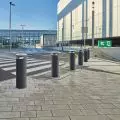Streetcar a chance for urban greenery
Streetcar routes as a supplement to parks? That's what Warsaw researchers from the Warsaw University of Life Sciences are proposing. But greenery still tends to be a flower in the cap of road investments. Proof: the latest Poznań implementation - a tramway to Naramowice. Thinking about new thoroughfares, therefore, needs to be switched to a new track. With the participation of architects and landscape specialists.
Sedum was this spring the protagonist of numerous photos posted on the online services of Poznan authorities. The green track was planted with it, which foreshadowed how friendly the new streetcar route under construction - a more than three-kilometer long investment that will greatly facilitate access to the Naramowice district - will look. On Facebook, citizens gave the photos hundreds of likes. After a few months, however, they saw the full, less joyful picture.
Gravel in place of greenery
The wide and long lanes between the greened tracks and the bicycle path were permanently strewn with... coarse gravel. An unexpected change of places. The greenery that is planted in the spaces next to the tracks went where gravel used to be poured. And vice versa: gravel replaced the green belt. Pointless, but enough to boast of an "innovative" and "environmentally friendly" approach to a road project.
Photo: Jakub Głaz
This, by the way, is not the end of the story. A row of typical and rather ugly barriers has sprung up in the place where regulations dictate the separation of tracks from pedestrian and bicycle paths, although - also in accordance with the regulations - they can be replaced, for example, with a hedge, which would look much better than the grapevine planned for the unsightly barriers in the future. It is good that along the route at least new trees are planned to be planted. But neighborhood activists have already had to fight fiercely for linear parks along the Naramowice section of the route.
Photo: Jakub Glaz
- What can be seen here is a certain lack of a comprehensive approach to the design of the entire transportation system, comments Dr. Michal Beim, an expert on transportation and urban planning and a lecturer at the University of Life Sciences in Poznań. - A fence of typical elements can be replaced not only with a hedge, but also, for example, with low acoustic screens planted with ivy. And gravel is usually poured under overpasses, where nothing will grow. In open space, this is a waste. Meanwhile, there's nothing worse than feeling a sense of wasted space that could be used for greenery, benches, bike racks or other resident-friendly infrastructure.
landscape architect needed
In fact, there is nothing new: the construction of a new route, like many other thoroughfares in the country, is primarily the domain of road builders, who still do not understand the importance of the aesthetic, landscape and climate aspects of the investments they make. Unless the desired solutions are imposed on them, they themselves are unlikely to change their current way of thinking. Suffice it to recall the successful battle over trees growing in the ground along Świętokrzyska Street in Warsaw, which was rebuilt several years ago.
- That's why it's necessary to involve landscape architects and greenery specialists in design work from the beginning," Beim declares, adding that in the face of climate change, the obligation should be to maximize the greening of new or modernized transportation routes: from tall trees, where possible, to lawns or flower meadows in places where underground infrastructure and regulations don't allow for larger plantings.
Is this possible in Polish realities? As much as possible. In the pages of "Gazeta Wyborcza" this was recently proved by a team of scientists from the Warsaw University of Life Sciences, led by Jan Lukaszkiewicz, PhD. According to him, 185 km of Warsaw trackways can be transformed into fully-fledged green corridors. The example of Nowa Marszałkowska fits perfectly into these assumptions.
So, are green tracks or bus stops with green roofs just a flower to go with them? Not always. The context is important.
- Planted green tracks should be part of a much larger green puzzle," comments Dr. Beim, mentioning Freiburg im Breisgau, from which the renaissance of green tracks known in Europe already before the war began. Indeed: even the catenary poles in this German city are overgrown with dense vines.
But what about "green" bus stops, where sparse greenery appears only on rooftops? Beim says they make sense, but on the condition that they are installed next to, and not instead of, the dewy greenery that should provide shade and respite at bus stops.
design longer!
In addition to greening, new transportation routes should also be much more strongly part of urban design. So that, for example, new developments planned along them are optimally combined with access to bus stops located in the most convenient places.
- Cities must therefore widely consult their intentions with residents, but also, for example, with developers. This takes time, which is why we should follow the example of Germany, where they design long and thoughtfully, but build quickly. In our country it is generally the other way around," comments Beim.
He also recommends local government investors and planners to read the publication "Tramways à la française, " edited by Delphine Desveaux, a compendium of successful streetcar routes built in recent decades in five French cities and Casablanca. "Today, the streetcar is one of the foundations of our metropolises. In the future, it will be - perhaps - the driving locomotive of them," - reads the publication's executive summary. It's high time for "Tram in Polish" - a challenge not only for road engineers, but also for architects and landscape designers.






















